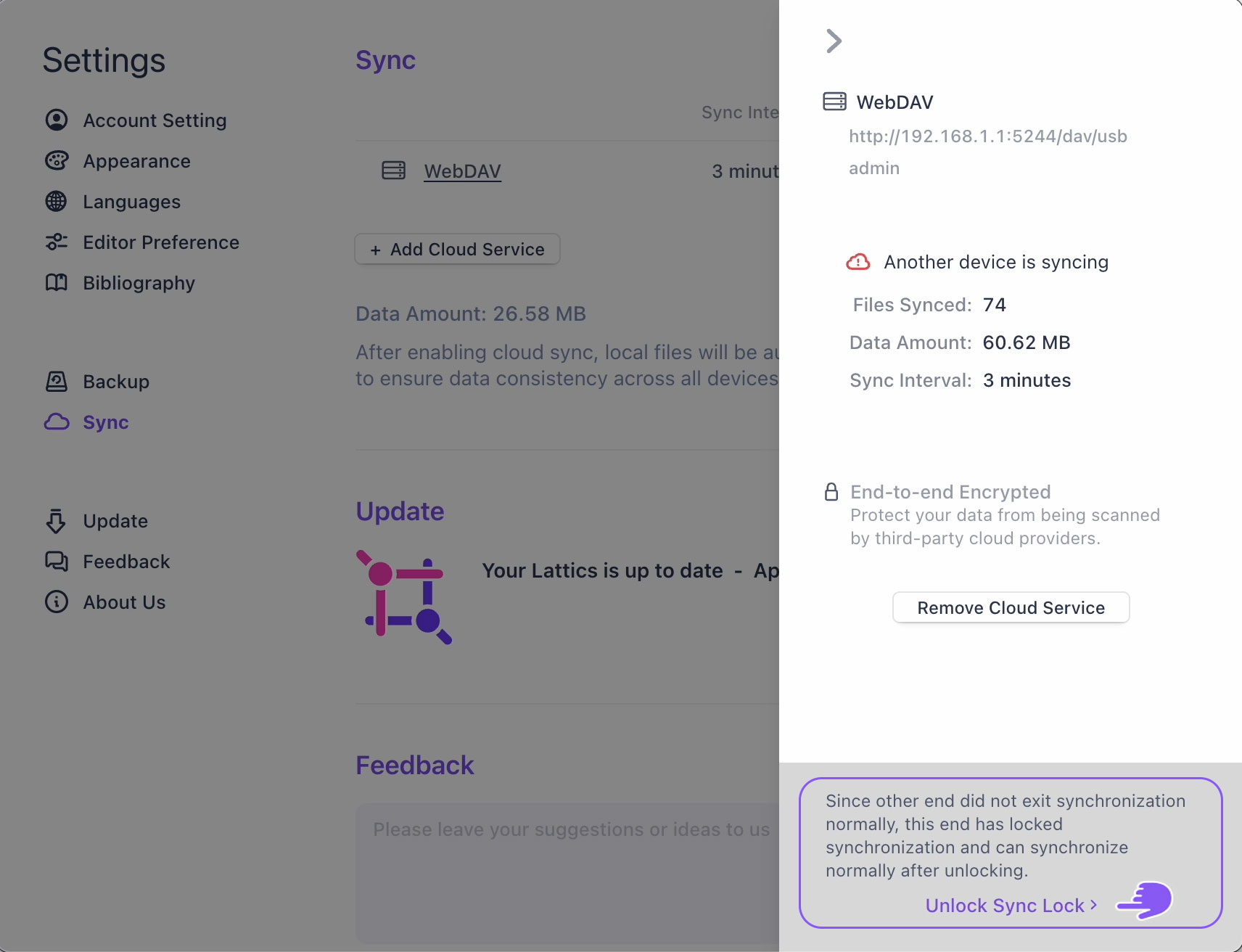Third-party Sync
Many note-taking and writing apps upload data to the cloud by default. However, the emergence of AI algorithms such as LLM in recent years has caused people's content and data to be used to train AI without their acknowledge, causing their data privacy to be leaked and violated.
In order to ensure the security of data privacy, Lattics stores data locally by default and does not upload it to the cloud. If you need to synchronize data between multiple devices, you need to use a third-party cloud storage service to achieve this.
Lattics provided several special features for 3rd-party sync:
Supports various of services
Lattics supports WebDAV, Jianguoyun, OneDrive, Google Drive etc mainstream and commonly used cloud storage services
Configuration Methods for Several Commonly Used Cloud Services That Support WebDAV:
NextCloud
- Configuration Reference: NextCloud WebDAV Configuration
- Account: Use the username you registered.
- Password: You can choose to use the main account password or generate a dedicated access token through Security Settings as the password.
- URL Format: You need to obtain your own exclusive server address in the personal account of NextCloud. Format: https://{host}/{path}/remote.php/webdav
pCloud
- Configuration Reference: pCloud WebDAV Configuration
- Account: Directly use the registered email address.
- Password: Directly use the registered password.
- URL Format:
- US server (US): https://webdav.pcloud.com
- European server (EU): https://ewebdav.pcloud.com
Yandex Disk
- Configuration Reference: Yandex WebDAV Configuration
- Account: Use the email address you registered.
- Password: You need to generate a WebDAV dedicated password. The setup steps are as follows:
- Log in to the Yandex ID Management Page.
- Click Create New Application Password.
- Set a name for WebDAV (for example, "WebDAV") and generate a dedicated password.
- Save the generated password for WebDAV configuration.
- URL Format: https://webdav.yandex.com
Jianguoyun
- Configuration Reference: Jianguoyun WebDAV Configuration
- Account: Use the email address you used when registering for Jianguoyun.
- Password: You need to go to the Jianguoyun official website to generate a dedicated password. The specific steps are as follows:
- Log in to the Jianguoyun official website Personal Account.
- Open the Account Settings page and find Security Settings or Application Passwords.
- Create a dedicated password for WebDAV and save this password for configuration use.
- Limitations:
- File Size: The upload limit for a single file is 500MB.
- Access Frequency:
- Free version: Up to 600 requests every 30 minutes.
- Paid version: Up to 1500 requests every 30 minutes.
Supports WebDAV
WebDAV is a standard protocol for network storage. If you know about server knowledge, you can build a service by yourself and provide it to your team. This method will be the safest absolutely because it is completely controlled by you.
End-to-end encryption
Lattics uses end-to-end encryption in 3rd-party sync to ensure data security, that is, data and content uploaded to third parties can only be decoded and accessed through the Lattics client and by logging into your account. Under this protection, although the data is stored in the third party, they cannot read the content in the data, and cannot use them for AI training.
Simple and Controllable
Lattics provides a very simple and convenient way to add, manage, and delete third-party sync services, all in one place in the settings interface. After creating a third-party sync service, a status indicator will appear at the top of the main interface, showing how long it has been since the last sync and whether a sync error has occurred.
After the third-party sync is created, it will automatically start sync at regular intervals by default. You can also click on the status indicator at the top of the interface to turn off automatic sync and control it manually.
The benefit of automatic sync is that it is very convenient, but for some third-party syn services, there will be a limit on the number of sync requests, such as the free service of Jianguoyun. If there are many files and data, manual sync will be easier to succeed
Note:
To avoid data conflicts caused by multiple devices in sync at the same time, Lattics uses "sync lock" technology, so when one device is synchronizing, other devices cannot be synchronized.
If there are no other devices synchronizing, but you find that your local device always prompts that other devices are synchronizing, you can click on the sync source, enter its details interface, and click "Unlock Sync Lock" at the bottom, then you can synchronize your local device normally.
